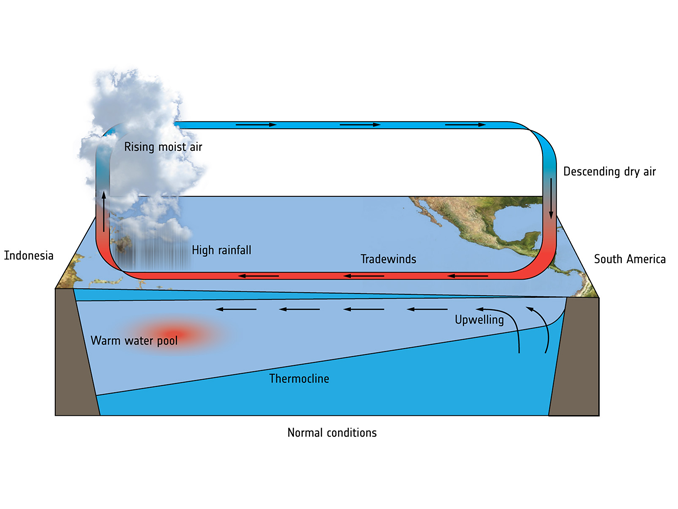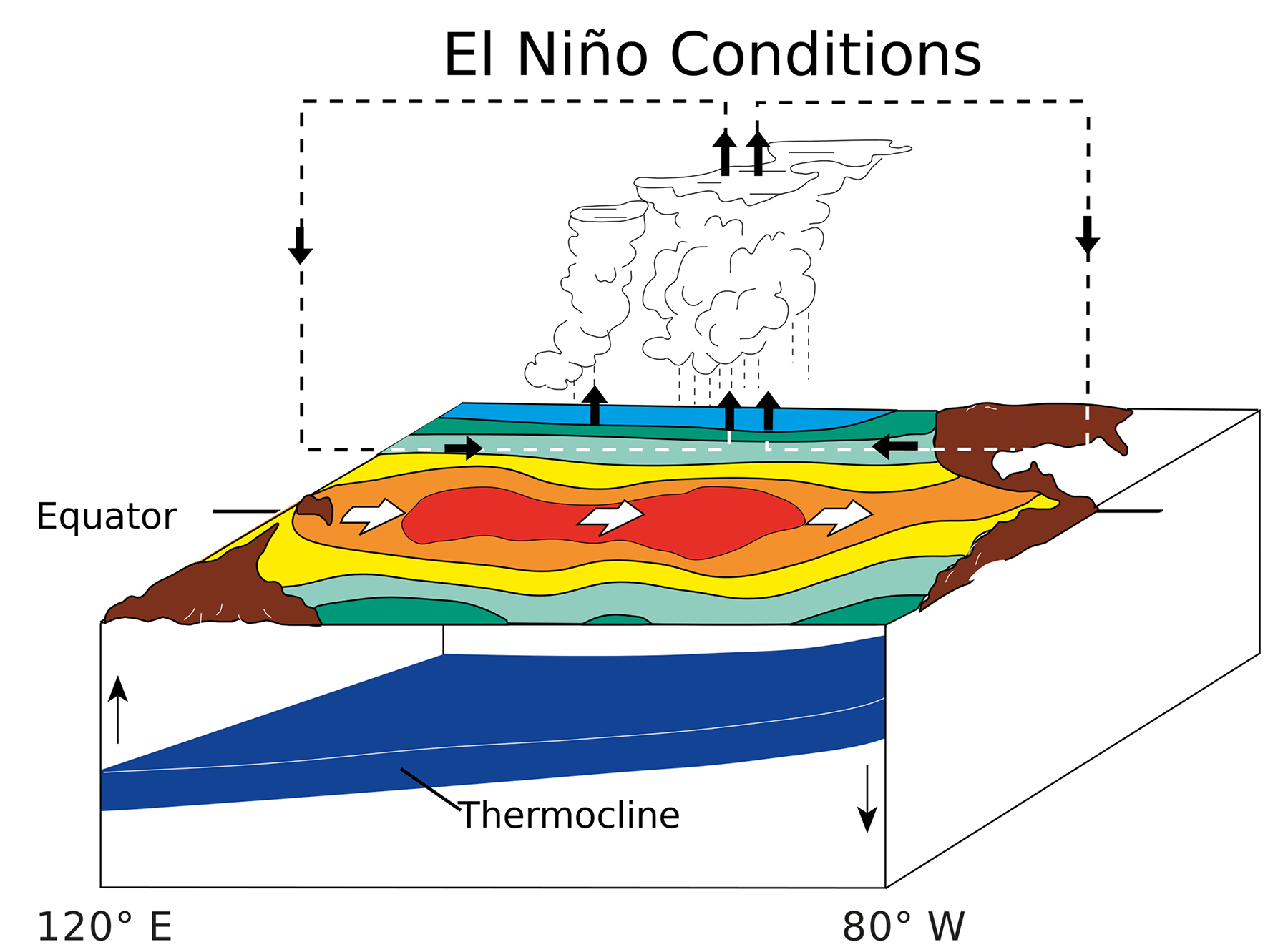Does La Nina Cause Upwelling
ENSO is the most influential natural climate pattern on Earth. Worst floods experienced in Queensland Australia in 2010 because of the strong La Nina events.
These effects are usually strongest during the winter months when the jet stream is strongest over the United States.

Does la nina cause upwelling. So is a major influence on Australias climate. In this pattern strong winds blow warm water at the oceans surface from South America to Indonesia. Occurrence of Typhoons Hurricanes and very cold weather.
Catastrophic floods in some parts of the world cause by extreme La Nina events. We can see this upwelling effect directly when looking at the temperature by depth during a La Nina and an El Nino event. Unusually strong eastward-moving trade winds and ocean currents bring this cold water to the surface a process known as upwelling.
What are La Nina conditions. Why do El Niño and La Niña occur. The first three months of the year during a La Niña typically feature below normal precipitation in the Southwest the central and southern sections of the Rockies and Great Plains and Florida.
During El Niño the trade winds are very weak and upwelling doesnt happen. La Niña is caused by a build-up of cooler-than-normal waters in the tropical Pacific the area of the Pacific Ocean between the Tropic of Cancer and the Tropic of Capricorn. In winter winds blow from the south to the north resulting in downwelling.
Every few years the cold nutrient-rich water is replaced by unusually warm water that is low in nutrients leading to a decline in fish populations. Duxbury et al 2002. Meanwhile the odds of surplus precipitation increase across the Pacific Northwest in the northern Intermountain West and over scattered sections of the north-central states Ohio.
Unusually strong eastward-moving trade winds and ocean currents bring this cold water to the surface a process known as upwelling. La Niña is caused by a build-up of cooler-than-normal waters in the tropical Pacific the area of the Pacific Ocean between the Tropic of Cancer and the Tropic of Capricorn. 96 El Niño and La Niña As we saw in the previous section coastal upwelling off of Peru makes that region one of the worlds most productive fishing grounds.
America to AsiaAustralia and warm surface water is dragged away from the coast and colder nutrient water rises to shallow depths. La Niña is caused by a build-up of cooler-than-normal waters in the tropical Pacific the area of the Pacific Ocean between the Tropic of Cancer and the Tropic of Capricorn. This cold water ends up on the coast of South America.
Unusually strong eastward-moving trade winds and ocean currents bring this cold water to the surface a process known as upwelling. Over 10000 people were displaced and forced to evacuate then it was estimated that over 2 billion worth of property were lost in this disastrous flood. Is La Nina wet or dry.
Very heavy rains and flooding in the Philippines Brazil Malaysia and Indonesia are also largely determined by the La Niña. La Niña has the opposite effect of El Niño. But every so often the conditions in the region are very different.
During the summer winds blow from the north to the south and water moves offshore resulting in upwelling along the coast. During La Niña events trade winds are even stronger than usual pushing more warm water toward Asia. As upwelling is increased nutrients can easily get to more marine life.
Definition of La Niña. During a La Nina event the changes in Pacific Ocean temperatures affect the patterns of tropical rainfall from Indonesia to the west coast of South America. Unusually strong eastward-moving trade winds and ocean currents bring this cold water to the surface a process known as upwelling.
This warm pool expands to cover the tropics during El Niño but during La Niña the easterly trade winds strengthen and cold upwelling along the equator and the West coast of South America intensifies. How does La Nina affect weather patterns. These differences indicate that a La Niña event does not necessarily increase phytoplankton productivity.
La Niña is caused by a build-up of cooler-than-normal waters in the tropical Pacific the area of the Pacific Ocean between the Tropic of Cancer and the Tropic of Capricorn. An irregularly recurring upwelling of unusually cold water to the ocean surface along the western coast of South America that often occurs following an El Niño and that disrupts typical regional and global weather patterns especially in a manner opposite to that of El Niño. Why does La Nina occur.
Unusually strong eastward-moving trade winds and ocean currents bring this cold water to the surface a process known as upwelling. The first image below shows the water temperature by depth during the 20152016 El Nino event. This summer upwelling produces cold coastal waters in the San Francisco area contributing to the frequent summer fogs.
La Niña is caused by a build-up of cooler-than-normal waters in the tropical Pacific the area of the Pacific Ocean between the Tropic of Cancer and the Tropic of Capricorn. As more and more surface dwelling creatures receive these vital nutrients the more they can reproduce creating large populations of various forms of marine life. El Niño and La Niña affect both the ocean and the atmosphere.
La Niña is associated with the higher than normal rainfall in the central Andes South America often causing catastrophic flooding. La Niña is a weather pattern that occurs in the Pacific Ocean. Study are much lower.
Sea-surface temperatures along the equator can fall as much as 7 degrees F below normal. ENSO swings back and forth every few years. What typically happens is that the trade winds move from S.
El Niño is a series of weather patterns that occur when temperatures along the South American west coast rise due to a lack of trade winds that usually drive the warm equatorial waters towards the Southeast Asian coast and cause an upwelling of cold water in the east as is the case with La Niña. As the warm water moves west cold water from the deep rises up to the surface. Periods of weaker- or stronger-than-average easterly trade winds initiate El Niño and La Niña.
When compared with previous studies on La Niñas affect on upwelling though these results appear to be inconclusive and require further study with more sampling locations. As opposed to El Nino La Nina increases the upwelling cycles in the ocean. El Niño and La Niña are the warm and cool phases of ENSO pronounced en-so.
El Nino and La Nina events can cause natural extreme events such as bushfires heatwaves floods and cyclone. Off the west coast of the Americas upwelling increases bringing cold nutrient-rich water to the surface. One of the most important climate drivers in the world.

El Nino Vs La Nina What S The Difference Earth How

9 6 El Nino And La Nina Introduction To Oceanography

What Are El Nino And La Nina Earth Org Past Present Future
Posting Komentar untuk "Does La Nina Cause Upwelling"